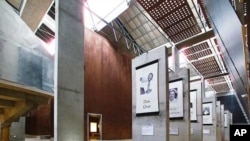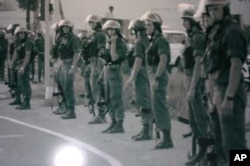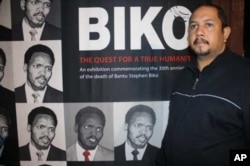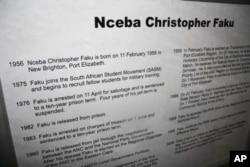Even when the weather’s stiflingly hot, the interior of the Red Location Museum in Port Elizabeth on South Africa’s south coast is cool. The facility’s made largely of blue steel, oxidized iron and mottled concrete. Its angular pewter façade is reminiscent of the many factories that blight the city, which is the industrial center of South Africa’s motor trade.
“This museum, in both design and exhibits, reflects the reality of this area’s struggle against apartheid. The struggle wasn’t warm and sunny; it was painful. It was like a never-ending winter,” says Chris du Preez, curator and acting director of the institution, which has won several international architectural awards.
Corroded metal walkways hang over visitors, reinforcing the impression of a prison. There are few bright colors to attract attention to exhibits inside Red Location Museum, only shades of grey. Corners ooze dark shadows. There are no carpets to soften steps on the granite floors. Voices echo ominously through the dim passages.
“With this space, the designers wanted to create an uneasy, disturbed atmosphere; it’s almost like you’re isolated and separated from the rest of the world when you come in here,” says Du Preez. “Alone, oppressed, confined ….”
He adds, “The factory design as seen from the outside is in honor of Port Elizabeth’s worker unions, who by means of industrial unrest and strikes played a big part in ending apartheid…. And, yes, the museum also resembles a jail, to honor all those in this region who were imprisoned and executed by the apartheid state.”
Memory boxes
The repository has become known internationally as one of the most remarkable human rights memorials in the world. Upon entering, visitors are confronted with huge, looming slabs of cement. The stone monoliths display large photographs of anti-apartheid fighters – some still living, others long dead – who were active in Red Location, the impoverished township that’s home to the museum. The activists’ stories are told on sheets of paper below their images.
In other exhibitions, local events that proved to be turning points in the war against white supremacy are conveyed by words, pictures and sound. As a visitor approaches a photograph of a line of helmeted white policemen, faces taut and brawny arms holding automatic rifles, heart-wrenching sobs emerge from an overhead speaker.
The terrified crying represents some of the victims of the so-called “Langa massacre.” In 1985, after a funeral, apartheid security forces opened fire on a crowd of mourners in Maduna Road in nearby Langa township, killing 20 people.
But the museum’s centerpieces are 12 massive “memory boxes,” 12 by 6 meter high constructions made from the same red-rusted corrugated iron that locals have used for decades to construct their shacks, and from which “Red Location” takes its name.
“Each memory box exhibits the life story or perspective of individuals or groups who fought against the apartheid regime,” Du Preez explains.
In the memory box in honor of activist Vuyisile Mini, a gallows rope hangs from the ceiling. In 1964, the Port Elizabeth trade unionist became one of the first African National Congress (ANC) members to be executed by the apartheid state. A narrator tells Mini’s story; it booms from speakers as soon as a visitor sets foot inside the tarnished edifice.
Not a ‘normal’ museum …
The museum’s positioning is highly symbolic. It was in the Red Location area, in the early 1950s, that former president Nelson Mandela formulated his “M-Plan” to organize ANC members into a nationwide underground network. It was here, in the early 1960s, that the ANC first took up arms against the apartheid government when it established the first branch of its military wing, Umkhonto we Sizwe, or “Spear of the Nation.” And throughout the 1970s and 1980s, Red Location witnessed many vicious battles between black militants and white soldiers and police.
Yet despite the institution’s ideal location in terms of historic symbolism, heritage expert Du Preez says the museum has been “beset by challenges” from the beginning. In 2002, when government began building it, the local community – the very people who stood to benefit from the project – launched protests against it.
“There was a little bit of problems because the community voiced their dissatisfaction. They wanted houses; they were not interested in a museum,” says Du Preez.
Adding to the resistance, he explains, was the fact that for many black South Africans a museum was a “very foreign concept … In the past, museums and that sort of cultural kind of thing was limited to white South Africans.”
The curator says many black South Africans still don’t know what a museum is.
“Most of the people around here thought that we were going to have animals here. I was constantly asked when I started (work here), ‘When are you going to bring the animals?’ Some people still come in here expecting to see animals, as if this is a zoo!” he laughs.
With all the confusion and opposition, the project stalled for two years. But as soon as the provincial government built some houses in Red Location and promised more, construction resumed.
The museum was built and launched in 2006, but new challenges soon emerged.
Ironic, ‘contradictory’ memorial
Du Preez explains, “This is the first museum (in the world) that’s actually based right in the middle of a (poor) township. That causes all sorts of problems. For example, the museum is operated by the local municipality and therefore it’s seen as a government institution....”
This means that when the locals are unhappy with state service delivery, as they often are, they knock on Du Preez’s door. He laughs wryly, “When people have problems (with government) and they want to protest or show their (anger), they do it here in front of the museum!”
Du Preez thus describes the facility as “not a normal museum” and a “very complex, even contradictory space.” He agrees it’s ironic that something that’s been built to honor activism has itself become the target of community activism.
In the same way as the people of Red Location fought to oust the apartheid state, so do they continue to fight perceived injustices perpetrated by the present ANC government … using the museum as a focal point.
Du Preez, however, understands why the people living around the institution often vent their fury on its premises.
“Some of these people still live in shacks here; they still use the bucket system (because they have no toilets); they use communal taps; unemployment is major in this area,” he says.
15,000 visitors every month
But Du Preez insists the Red Location Museum is now “very much accepted” by the local community, despite the frequent anti-government demonstrations on its grounds.
“We don’t even need … security in this area. We’ve never had a break-in here; we’ve never had problems in terms of crime here. Because people protect this place; it’s their place,” he says.
Evidence of the facility’s growing popularity is found in visitor figures. They show up to 15,000 people visiting it each month. Many of these visitors, says Du Preez, are young white South Africans. This further encourages him.
“They don’t see color anymore. They don’t have that (apartheid) baggage.… They show great interest in the struggle history; they’re moved by it just like any black kid is moved by it,” Du Preez says.
Outside the museum is the noise of a multitude of grinders, jackhammers and drills. Scaffolding rattles as workers ascend it. A major expansion to the apartheid memorial is underway. An arts center and arts school are being built, as well as Africa’s first completely digital library. Here, users – through computers – will soon have access to books and other sources of information that are wholly in digital form, speeding up research and learning.
Through all the change at and ongoing challenges to Red Location Museum, Du Preez is certain that it will continue to be a venue for vociferous demonstrations against the state. And he says he’s “totally at ease” with this.
He smiles, “In a sense, the protests have themselves become exhibitions – and proof that South Africa is finally a democracy.”
















